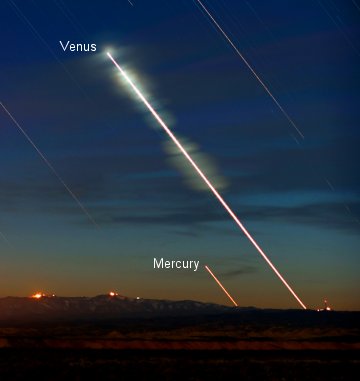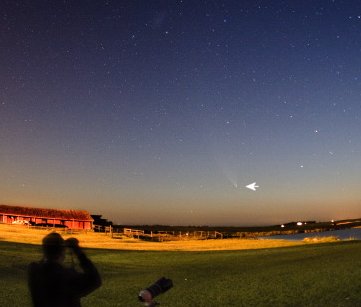 Did you sleep through the auroras of Dec. 14th? Next time get a wake-up call: Spaceweather PHONE.
Did you sleep through the auroras of Dec. 14th? Next time get a wake-up call: Spaceweather PHONE.
ASTEROID FLYBY: Mark your calendar. On March 31st, a 2-km wide asteroid named 2006 VV2 will glide past Earth. There's no danger of a collision: the space rock will be 8.8 times farther away than the Moon. The flyby is interesting because it is so bright, between 9th and 10th magnitude, making 2006 VV2 an easy target for backyard telescopes with CCD cameras. [3D orbit] [ephemeris]
EVENING PLANETS: When the sun sets tonight go outside and look west. You'll see two planets beaming through the glow of sunset: Venus and Mercury.

Long-exposure photo credit: Amir Hossein Abolfath of Ghom, Iran
This is a great week to see the two planets together. Mercury reaches its maximum elongation (apparent distance) from the sun on Feb. 7th, making it unusually easy to see and a charming companion for always-bright Venus. Take a look: finder chart.
more images: from Domenico Licchelli of Lecce, South of Italy; from from Benjamin Poupard of Reims, France; from Ante Pavlovic of Zagreb, Croatia; from Dave Lengyel of Brighton, Ohio.
COMET MCNAUGHT: Now that the full Moon is out of the way, observers in the Southern Hemisphere are spotting Comet McNaught again. "It was still visible to the naked eye--barely," reports Mendonca Jr of Pousada Caină, Brazil, who took this picture on Feb. 3rd:

Photo details: Canon 20D, 50mm lens, f2:8, 30 seconds, ISO 400
The comet is fading as it recedes from Earth, but it remains very interesting: A team of astronomers using the ESO's 3.5-meter New Technology Telescope in Chile have just announced their observations of "strong spiral jets extending at least 32,000 km from the comet's nucleus." [C. Snodgrass et al., IAU Electronic Telegram 832] Telescopic observations of this comet should prove fruitful for many weeks to come.
Comet McNaught Photo Gallery
[finder chart] [ephemeris] [comet camera]

